E-environment: Environment, an important pillar to building a sustainable future
12 Jun 2017 09:00h - 10:45h
Event report
[Read more session reports from WSIS Forum 2017]
The moderator of the action line C7 meeting Mr Omar Baddour, Chief of Data Management Applications, World Meteorological Organization (WMO), presented the aim of the round table and invited speakers to discuss several initiatives and projects that contribute to progress in achieving the environmental goals using ICT, in environmental protection and sustainable exploitation of resources, and in the establishment of monitoring systems to forecast disasters, particularly in developing countries.
Mr Rupa Kumar Kolli, Chief World Climate Applications Services Division, WMO, introduced the Climate Service Information System (CSIS) and said it took eight years to establish the Global Framework for Climate Services and to generate and disseminate time and space information on climate. CSIS is considered to be the operational centre of the Global Framework as it deals with climate data monitoring, predictions, and projections on a variety of places and time scales. CSIS collects and distributes data according to the needs of its users through the procedures agreed by various stakeholders. CSIS is systematically organising information generated in different places and by different ways. Rupa explained how the Climate Services Toolkit includes the data from CSIS, software, and a user interface. It works on the logic of ‘push’ – making users aware of what is going on, and ‘pull’ – responding to users’ requirements for specific data and predictions.
Mr Anthony Lehmann, Professor, Institute for Environmental Sciences, University of Geneva, delivered a talk on the importance of addressing multiple issues of SDGs simultaneously as population, climate, and land use are interconnected. Lehmann proposed to monitor indicators for SDGs in a stable way. These indicators are based on a set of variables: soils, energy, water, climate, biodiversity, extra activities. He also introduced the ERA-Planet project on observing the changing planet.
Mr François Grey, Director of Digital Strategy and Coordinator of Citizen Cyberlab, University of Geneva, gave several illustrations of crowdsourcing projects aimed at achieving the SDGs and based on ICT use and innovations. He first spoke about the two-month Geneva-Tsinghua Summer school aimed at developing technologies to achieve SDGs. Grey also showed the concept of an interactive trash can – Ecan – developed for crowdsourced waste analysis. Finally, he introduced Copernicus Emergency Management Service that provides crowdsourced social media analysis for mapping early warning for disasters.
Ms Francesca Cenni, Programme Officer, Secretariat of Basel, Rotterdam and Stockholm Conventions, highlighted the problem of ICT waste and dumping. She referred to SDG 12.4 on responsible production and consumption and stressed the goal to reduce 50% of redundant e-waste by 2020. She said it can be achieved by developing specific regulations on e-waste and guidelines for trans-boundary movements of e-waste. Cenni highlighted the necessity of defining what is e-waste and what are the responsibilities of e-waste collection. She also introduced the idea of leasing schemes for producers of ICT equipment.
Mr Orhan Osmani, Emergency Telecommunications Officer, ITU, shed light on ITU’s work on e-environment in three main areas – standardisation, development, and radio communication. She explained that the majority of work is done in the development sector and includes several projects:
- Early warning systems in Uganda and Zambia
- E-waste recycling plant in Argentina
- E-waste monitoring
Osmani also described the areas of action for ITU in e-enviromnent:
- Climate change adaptation
- ICT equipment energy efficiency (example of standardised chargers for phones worldwide)
- ICT waste management and safe processing
- Smart solutions for cities and rural areas
- Technical ideas for job creation and innovation
The session ended up with recommendations to enhance the mechanisms for integration of national-level systems of environmental data monitoring systems and to improve the interaction of climate data providers and users.
by Ilona Stadnik
Related topics
Related event

